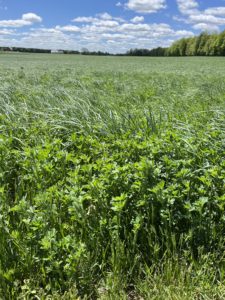Adding Grasses to Alfalfa – Enhancing Carbon Capture and Other Benefits
By Jim Sheppard | May 31, 2022
 Agriculture can be a source of greenhouse gas release and be a biological system that removes carbon from the atmosphere. Sources of emission include fertilizer production and use, fuel use, soil disturbance through tillage, manure use, and harvest losses. Dairy and beef also contribute through enteric methane release. Photosynthesis removes carbon from the atmosphere, creating organic carbon in the form of plant material. Though much of the organic carbon is recycled back to the atmosphere, some carbon can be captured and stored in the soil.
Agriculture can be a source of greenhouse gas release and be a biological system that removes carbon from the atmosphere. Sources of emission include fertilizer production and use, fuel use, soil disturbance through tillage, manure use, and harvest losses. Dairy and beef also contribute through enteric methane release. Photosynthesis removes carbon from the atmosphere, creating organic carbon in the form of plant material. Though much of the organic carbon is recycled back to the atmosphere, some carbon can be captured and stored in the soil.
Alfalfa is known as an excellent carbon crop. The USDA model, COMET Planner, estimates 0.22 tonnes CO2eq are captured annually when a perennial, such as alfalfa, is added to a crop rotation.
When grasses are added to an alfalfa seeding, models predict carbon sequester increasing +3.5X. The Nori carbon model increases its estimate from 0.15 tonnes for straight alfalfa, to 0.86 tonnes when adding grasses. A six-year Canadian study calculates carbon sequester by yield, and estimated alfalfa with grass could sequester 0.35 tonnes of CO2eq per tonne of hay harvested, +/- 40%. The range of estimates by various models and the margin of error show how we need to expand model testing and develop low-cost methods of carbon change verification.
In addition to carbon sequester, alfalfa with grass provides the grower with many additional benefits.
- New grass varieties have higher yield, protein, and nutrient content.
- Grass varieties are available that are later maturing, in sync with alfalfa maturity for better digestibility. Higher digestibility in feed also means less manure produced.
- Grass fiber digestibility complements dairy diets high in corn silage.
- Alfalfa and grass seed can be premixed at the seed plant and packaged together for farmer convenience.
- Cost of seeding alfalfa / grass mixtures is similar or less than seeding straight alfalfa.
- Alfalfa and grasses can be planted together with the same equipment, at the same time.
- Adding grasses can significantly increase the yield over pure alfalfa in the seeding year, up to 1-ton dry matter per acre.
- Grass will spread into areas where the alfalfa stand thins. This lessens the opportunity for weed growth and the exposure of bare soil to erosion.
- Nitrogen fixed by alfalfa is sufficient for top alfalfa and grass yields. No synthetic nitrogen needs to be applied.
- Grasses increase the alfalfa tolerance to traffic from harvest operations.
- Grasses increase the tolerance of alfalfa to manure applications.
- The digestible fiber in grasses can reduce non-fibrous carbohydrate in dairy rations, lessening or eliminating the need to add straw.
This project also hits the NRCS 5 Principles of Soil Health:
- Plant diverse crops
- Minimize soil disturbance
- Keep roots growing all year
- Keep soil covered
- Integrate livestock – grazing or spreading manure
Planting alfalfa/grass mixtures is common practice in the Northeast region where over 85% of the acres are planted with grass. The rest of the U.S. is less than 10%. This presents a huge opportunity for increased carbon capture. Dairy farmers that are searching for ways to lower their Greenhouse Gas footprint can make an immediate impact with this simple practice change.

